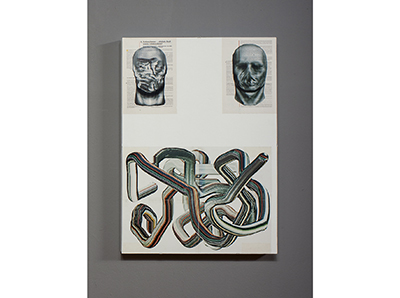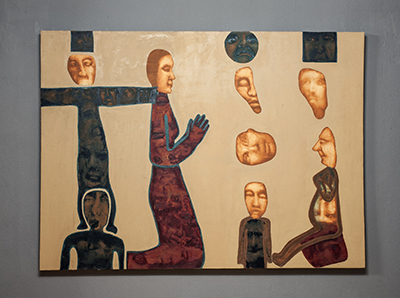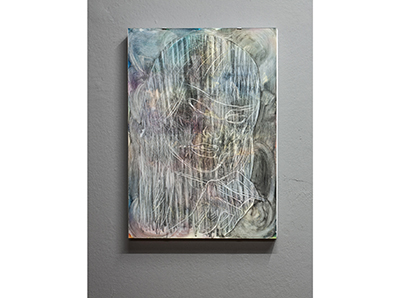
Andromeda - The Origin of Anxietycurated by Robert Gruber
kindly supported by: towner art gallery, eastbourne, ukworks by
Imants Daksis
Jeremy Glogan
Franz Zar
Opening 10.11.2016 / 19:00
11.11. - 29.11.2016
& by appointment
+43 650 555 9 666
gottrekorder@gmx.at
gottrekorder e.v.www.gottrekorder.com
A Anthropological Raptus, number 6/241
for gottekorder e.v. Graz
Vienna, 19.10.2016
Andromeda - The Origin of Anxiety
“Anxiety is a false concept.” ...
It refers to the possibility for the possibility of decision. Good. In the possibility lies the malaise, the unease, as an
anthropological quality with consequences. The consequences are quantitative. A quantity. The consequences
can be ‘great’; they are thus negotiated with reference to everyday humane existence. Great consequences –
small consequences. OK.
The possibility (for decision), the anxiety in the absence of the associated historical individual that quantifies it,
appears to be something detached. It does not enter into appearance within the same space of verification
(morality). It is not ‘negotiated’ at all.
Accordingly, anxiety is verifiable – for it is ‘given’ – as the uncertainty of the possible, contrasted with the
certainty of the impossible – mythic. Even ‘pre-mythical’. Pre-historic – and magical in its applicability. In any
case, in the sense that it is pre-historic, it is also pre-moral.
‘Magic has fundamentally nothing to do with religion; it is neither a primitive level of religion nor a specific zone
within individual religions. (Magic is knowledge of effective forces in the natural environment of human beings
and a means to their conquest, of protecting against harm and enforcing benefit. Thus magic is science, or as
applied science, technology.)’ *
Indirectly, anxiety no longer has much in common with religion. Is it the common origin of magic and religion?
Perhaps not even that. Religion is not beholden to anxiety. Religion is religion only when and because it is
beholden to itself and no longer treats its origin as negotiable. Thus a template detached from its origin, whose
motivation and whose peculiar rhetoric is no longer verifiable.
Here the following applies:
The lie is beholden to the truth! Its truth!
In this case it is not a ‘pseudo’: not something purported against better knowledge, a trick, but rather a true lie.
A truth based on the fundament of the lie; like repression, in which the repressed content no longer itself appears
in the area about which it (the lie) thinks, to which it refers.
The lie is therefore beholden to a specific truth; in the case of religion, to itself, for its ‘self’ is pure rhetoric,
or faith by convention.
Rhetorically, I could say that I realised this for the first time when …
it became clear to me that I experienced, or quantitatively, superlatively, ‘saw’ this or that.
That would fit. Hence a rhetorical form.
But is it true or not? I became in fact aware of this or that when I … This is a historical truth. But does it fit or not?
How could one know?
Matter, form and religion are per se the true lie. Not the lie against better knowledge (pseudo), but the truth of
the lie itself. Almost a principle that thereby obtains (already alone) because it marks and founds an origin,
with which it itself enters into thought and into the world! It thus determines the origin of its thought!
In form, matter becomes a function of rhetoric. A total ‘how’ that lets the lie of the (purported) content become
‘true’ because this ‘how’ is more fitting, quantitative. At least it seems fitting (rhetoric), and this corporeal
appearance (form) is sufficient. The body is the appearance of a lie, in this case a religious lie. If also a tautology.
The body of Christ (predominantly offered to view hanging on the cross) is not the incarnation of the question of
faith, that is, of the faith in a religion, but rather the origin of a dialectic that is already decoupled from this faith
and deemed ‘true’, whether or not one believes.
In this form (for otherwise the body is perhaps never existent), the body is the rhetoric of the true certainty of
faith, its beginning and end at the same time. A mute document in the flux of the attempt to develop morals.
Pure history.
And even if this anthropological premise should again become negotiable, within a moralism that verifies its own
development, it must still be noted that the premise will never be able to become the origin of anxiety in these
mouldings.
The question remains whether religion (and every forming of anxiety into specific fears)is a phenomenon of
anxiety.
It is phenotypical here that the possibility of diversity is repudiated as a menace in favour of a readjusted set of
regulations preaching guardedness, rigour and fear.
Thus whether and how anxiety can be an experience that leads, via perception, into a set of regulations and into a weltanschauung.
Anxiety remains. It is constant – albeit in the beyond.
* Helmet de Boor, Die Deutsche Literatur von Karl dem Grossen bis zum Beginn der Höfischen Dichtung 770 – 1170,
C.H. Beck’sche Verlagbuchhandlung, München, c 1949, p.89
B
‘Fear is a false concept’ .. and viewed as a whole, justifies the possible!
Andromeda, we’re coming!*
Through the earth,
through the damnations,
through the sun,
through caressing flames,
we begin
to stop the unstoppable,
Andromeda,
we’re coming.
Goodbye, unwritten physics,
goodbye, totalitarian chemistry,
goodbye, psychical anthropology
welcome, infinite geography!
Adieu, my old wigwam.
adieu, my old peace pipe,
adieu, beloved penguin nation
adieu, civilisation!
Adieu, my unprecedented orgasm
in you, beloved Earth;
Welcome!
Beloved Aurora, beloved Andromeda.
(*Imants Daksis)
Translated by Jonathan Uhlaner
A
Anthropologischer Raptus,
Nummer 6/241
für gottekorder e.v. Graz
Wien, 19.10.
2016
Andromeda – Der Ursprung der Angst
„Angst ist ein falscher Begriff“ ...
Er verweist auf die Möglichkeit zur Möglichkeit der Entscheidung. Gut. In der Möglichkeit liegt das Unwohlsein,
die Besorgnis, als eine anthropologische Qualität mit Folgen. Die Folgen sind quantitativ. Eine Größe. Die Folgen
können „groß“ sein; sie werden also in einem Bezug zur menschlich alltäglichen Existenz verhandelt.
Große Folgen – kleinere Folgen. Ok.
Die Möglichkeit (zur Entscheidung), die Angst ohne das zugehörige historische Individuum, dass sie quantifiziert,
scheint davon etwas Losgelöstes zu sein. Sie tritt nicht innerhalb desselben Verifizierungs-Raumes (Moral)
in Erscheinung. Sie wird gar nicht „verhandelt“.
Demnach ist sie – denn sie ist „gegeben“ - belegbar als die Ungewissheit des Möglichen, kontrastiert um die
Gewissheit des Unmöglichen - mythisch. Sogar „vor-mythisch“. Prä-historisch - und magisch, in ihrer Anwendbarkeit.
Jedenfalls in dem Sinn indem sie vor-historisch ist, auch vor-moralisch.
„Magie hat mir Religion grundsätzlich nichts zu tun, weder ist sie eine primitive Religionsstufe noch eine
bestimmte Zone innerhalb einzelner Religionen. (Magie ist Erkenntnis wirkender Kräfte in der natürlichen Umwelt
des Menschen und Mittel zu ihrer Bezwingung, Abwehr des Schadens, Erzwingung des Nutzens.
Somit ist Magie Wissenschaft bzw. als angewandte Wissenschaft Technik.)“ *
Mittelbar hat die Angst mit Religion nicht mehr viel gemein. Sie ist der gemeinsame Ursprung von Magie und Religion?
Vielleicht nicht einmal das. Religion ist der Angst nicht verpflichtet. Religion ist auch dann nur Religion,
wenn und weil sie sich selbst verpflichtet und ihren Ursprung nicht mehr als verhandelbar thematisiert.
Also eine vom Ursprung losgelöste Schablone, deren Motivation mit der ihr eigenen Rhetorik nicht mehr prüfbar ist.
Zwar gilt hierfür:
Die Lüge ist der Wahrheit verpflichtet! Ihrer Wahrheit.
Sie ist in diesem Fall nicht ein „Pseudo“: ein etwas vorgeben gegen besseres Wissen, also kein Trick,
sondern eine wahre Lüge.
Eine Wahrheit auf dem Fundament der Lüge; wie die Verdrängung bei der der verdrängte Inhalt im
Themenbereich dessen worüber sie (die Lüge) nachdenkt, worauf sie sich bezieht, selbst nicht mehr vorkommt.
Diese Lüge ist also einer spezifischen Wahrheit verpflichtet, im Falle der Religion: sich selbst, denn ihr „selbst“ ist
reine Rhetorik oder: Glauben per Konvention.
Rhetorisch: Ich könnte sagen, dass mir das dass erste Mal bewusst wurde, als ...
dass mir das in dem Moment klar wurde in dem ich dieses oder jenes erlebt habe, oder quantitativ superlativisch: „sah“.
Das würde passen. Also eine rhetorische Form.
Doch stimmt das? - nicht. Tatsächlich wurde mir das bewusst als ich ... Das ist die historische Wahrheit.
Allerdings passt es? - nicht. Wie soll man das wissen?
Material, Form und Religion sind per se die wahrhaftige Lüge. Aber nicht die Lüge wider besseres Wissen ( pseudo ),
sondern die Wahrheit der Lüge selbst. Beinahe ein Prinzip, dass als wahr gilt dadurch (schon alleine dadurch),
dass es den Ursprung eines Denkens markiert und begründet, mit dem es selbst ins Denken und in die Welt tritt!
Es bestimmt damit den Ursprung seines Denkens!
Das Material wird in der Form eine Funktion dieser Rhetorik. Ein totales „Wie“, dass die Lüge des (vermeintlichen)
Inhalts „wahr“ werden lässt, weil dieses „wie“ passender (quantitativ) ist. Zumindest erscheint es passend (Rhetorik),
und diese körperhafte Erscheinung (Form) ist ausreichend. Der Körper ist die Erscheinung einer, in diesem Fall religiösen Lüge.
Wenn auch einer Tautologie.
Der Leib Christi (in den überwiegenden Fällen aller Angebote hängt er am Kreuz) ist nicht die Verkörperung der Glaubensfrage,
also des Glaubens an eine Religion, sondern der Ursprung einer Dialektik die davon bereits abgekoppelt ist, und für sich
als „wahr“ gilt – egal, ob man nun glaubt oder nicht.
Er - der Körper - in dieser Form, denn anders wird er vielleicht nie existent - ist die Rhetorik der wahren
Glaubensgewissheit - ihr Anfang und Endpunkt zugleich. Ein stilles Dokument im Fluss der Entwicklungsversuche von Moralen.
Pure Historie.
Und selbst wenn, diese anthropologische Prämisse wieder verhandelbar sein sollte – innerhalb eines Moralismus der seine Entwicklungen
selbst verifiziert, ist doch zu bemerken, dass der Ursprung der Angst in diesen Ausformungen, es selbst nicht wird sein können.
Es bleibt die Frage, ob Religion (jede Ausformung von Angst zu konkreter Furcht) ein Phänomen der Angst ist.
Phänotypisch in diesem Sinne dass die Möglichkeit zur Diversität als Bedrohung verworfen wird zugunsten eines nachgestellten
Regelwerks der Vorsichtigkeit, Sorgfalt und Furcht.
Also ob und wie Angst eine Erfahrung sein kann, die via Wahrnehmung in ein Regelwerk und in Weltanschauung mündet.
Die Angst bleibt. Sie ist fortwährend - wenn auch jenseits.
*Helmet de Boor, Die Deutsche Literatur von Karl dem Grossen bis zum Beginn der Höfischen Dichtung 770 – 1170,
c 1949 C.H. Beck`sche Verlagbuchhandlung, München S.89
B
„Angst ist ein falscher Begriff“ ...und: aufs Ganze gesehen, das Mögliche rechtfertigen!
Andromeda, wir kommen!*
Durch die Erde,
Durch die Verdammungen,
Durch die Sonne,
Durchs Flammenstreicheln
Beginnen wir,
Das Unaufhaltsame aufzuhalten,
Andromeda,
Wir kommen schon!
Adieu, ungeschriebene Physik,
Adieu, totalitäre Chemie,
Adieu, psychische Anthropologie,
Sei willkommen, unendliche Geografie!
Adieu, mein altes Wigwam
Adieu, meine alte Friedenspfeife,
Adieu, geliebte Pinguinnation,
Adieu, Zivilisation!
Adieu, mein noch nie dagewesener Orgasmus
In dich, geliebte Erde;
Seid Willkommen!
Geliebte Aurora, geliebte Andromeda.
(*Imants Daksis)

Franz Zar, O.T. (LOGIE UNGEACHTET SEINER FORMALEN QUALITÄT MUSS ICH ES ZERSTÖREN WENN ICH DIE ENTSPRECHENDE IDEOLOGIE BEKÄMPFEN WILL SEHE ICH VON DEN POLITISCHEN HIS), 2013, Holz, MDF, Außendispersion, Tintenstrahldruck auf Papier, Tintenstrahldruck auf Folie, Glas, 84 x 59,4 x 5,5 cm

Franz Zar, O.T. (DIE BILDERSTÜRMER DES SECHZEHNTEN UND SIEBZEHNTEN JAHRHUNDERTS BEGREIFEN DIE ZU ZERSTÖRENDEN BILDER UND SKULPTUREN ALS REPRÄSENTATIONEN DER VON), 2013, Holz, MDF, Außendispersion, Tintenstrahldruck auf Papier, Tintenstrahldruck auf Folie, Glas 84 x 59,4 x 5,5 cm

jeremy glogan, untitled (second coming), 1989, oil on canvas, 186 x 135 cm, on loan from towner art gallery, eastbourne, uk

Franz Zar, DER MALER: UND FÜR MICH IST EINFACH AUCH DIESES PRODUZIEREN IN SERIEN ODER DIESES DIESES DENKEN IN IN WERKGRUPPEN AUCH IMMER SEHR WICHTIG WEIL DAS ALSO FÜR MICH HAT DAS IRGENDWIE SO WAS IST DAS SO WAS SINNBILDLICHES FÜR KÜNSTLERISCHE ARBEIT GENERELL, 2014, Holz, Außendispersion, Druckfarbe und Acrylgel auf Tintenstrahldruck auf Folie, Glas 59,4 x 42 x 4,5 cm